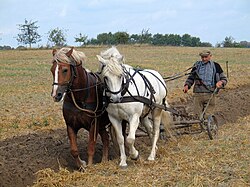| Morgen | |
|---|---|
| Unit system | German customary units |
| Unit of | Area |
| Symbol | Mg |
| Named after | The amount of land that can be tilled in the morning hours with a single-furrow horse or ox plough (measured from morning to noon). [1] [2] |
| Conversions | |
| 1 Mg in ... | ... is equal to ... |
| SI base units | 2,500 m2 |
| Imperial unit system | 2,990 sq yd |
A Morgen (Mg) is a historical, but still occasionally used, German unit of area used in agriculture. [1] Officially, it is no longer in use, having been supplanted by the hectare. [1] While today it is approximately equivalent to the Prussian morgen, measuring 25 ares or 2,500 square meters (0.62 acres), its area once ranged from 1,906 to 11,780 square metres (0.471 to 2.911 acres), but usually between 0.25 to 0.5 hectares (0.62 to 1.24 acres). [1] In the 20th century, the quarter hectare became standard for one morgen. [1] The Morgen unit of land measurement was also used in the Netherlands, Poland, Lithuania, and parts of the Dutch colonial empire, such as South Africa. It was also used in the Balkans, Norway, and Denmark, where it was equal to about 0.27 hectares (2⁄3 acre).
Contents
- Comparative measures to the Morgen in German-speaking regions
- Poland
- Austria–Hungary
- South Africa
- See also
- References

The word is identical to the German and Dutch word for "morning" because the measurement was determined by the area that can be ploughed with a single-furrow horse or ox plough in one morning (measured from morning to noon). [1] [2] The morgen was usually defined as a rectangle with sides of an even number of local rods, as turning while ploughing was to be avoided as much as possible.
The area measure of the morgen varied regionally, [1] but it was usually between one-fifth to half a hectare (2,000 to 5,000 m2). In northern Germany, there were also morgens of 6,000 to 9,000 square meters, and in the marshes, up to over 11,000 square meters. With the standardization in the late 19th century (the metrified morgen introduced by the North German Confederation in 1869), four morgens equaled one hectare in the German Empire, which is why the morgen was sometimes referred to as a quarter hectare (vha) to distinguish it from traditional measures.
In the 20th century, the morgen, with its size of 25 ares, established itself as an agricultural area measure. However, with the increasing average farm size (from 2005 to 2015 by 36.4% to 59.6 hectares or 238.4 morgens), it has lost significance compared to the hectare. [1] This is particularly evident where the average farm size in eastern Germany is around 1000 morgens.
The morgen was commonly set at about 60–70% of the tagwerk (German for "day's work") that referred to a full day of ploughing. The next lower measurement unit was the German "rute" or Imperial rod, but the metric rod length of 5 metres (16 ft) never became popular.